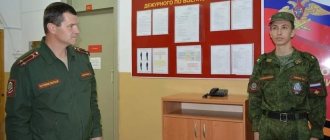Prerequisites
The military doctrine of national security of the Russian Federation was the result of a wide discussion in the media and a conference of the All-Russian Academy of Civil Aviation, where theoretical issues related to the use of weapons within the framework of the political activities of the state were discussed. The need to form a single document that includes key aspects of the problem arose at the end of the last century. By that time, almost all developed countries had already created a set of regulatory documents of this kind. The main provisions of the Military Doctrine of the Russian Federation were adopted in November 1993.
Definition
“Defense security” is a broader concept than “military security.” It is ensured by the efforts of the entire country or state, taking into account not only military, but also economic, information and other factors.
Doctrinal issues in one form or another are reflected in various documents:
Constitution; National Security Concept; Foreign Policy Concept; various legislative documents in peacetime and wartime (“Security Law”, “Defense Law”, “Law on Conscription and Military Service” and others); in combat and general military documents.
The most important doctrinal issues are accumulated in the foundations of the Military (defense) doctrine, for example:
- Security threats and resulting defense tasks;
- Political and legal foundations of the Military (defense) doctrine;
- Military-strategic foundations of the Military (defense) doctrine;
- Military-economic and military-technical foundations of the Military (defense) doctrine.
As a system of official views accepted in a state, military doctrines exist in any state.
The essence of the concept
The new Military Doctrine of the Russian Federation that exists today proclaims the officially accepted views of the leadership on the use of weapons to ensure the defense capability of the state. According to theoretical requirements, this document answers the following questions:
- With which opponents and how to prevent armed conflicts.
- What character can the struggle have, the tasks and goals of the state and the army during the conduct of hostilities.
- What military organization should be created to resolve armed conflicts, and in what directions should it be developed.
- What forms and methods should be used as part of military operations.
- How to prepare the state and army for war or the use of armed forces in conflicts.
The military security doctrine of the Russian Federation is focused on protecting the economic interests of the country. Its content is determined by the state’s capabilities to conduct armed conflicts. They, in turn, depend on the state of the economy, the level of development of scientific and technological progress and social infrastructure. The military doctrine of the Russian Federation performs informational, organizational and regulatory functions. They determine its key importance in matters of preparing the state and army to protect the interests of the country using the armed forces.
Russia's new military doctrine: Strategy or confrontation?
The beginning of the year in the military-political sphere of Russia was marked by the signing of a key document for the country’s defense capability - the New Military Doctrine. The main estimates already given by analysts are different. Another one is given in an interview with our publication by the President of the Academy of Geopolitical Problems, Colonel General Leonid Ivashov.
– Leonid Grigorievich, recently several fundamental documents for the country have been adopted, including the reform of the Russian Armed Forces, military doctrine and another treaty on the reduction of strategic offensive weapons. In your opinion, which one is more important?
– I believe that it is the military doctrine, because it must take into account the current and future state of the armed forces, including the strategic nuclear component, and it is the military doctrine, on the basis of a deeply scientific geopolitical analysis and strategic forecasting of world trends, that must determine the main directions of the construction and development of the armed forces. But not the other way around. And the START-3 treaty should organically fit into the logic of the military doctrine, become its core, if we declare that nuclear missile power is the guarantor of the security of the Russian state.
– If we talk about differences - after all, it will still be impossible to avoid comparisons - what are the fundamental changes in the new doctrine?
– Military Doctrine 2010 is proclaimed as a development of the 2000 doctrine, as a new fundamental document of Russian military policy. However, there are no fundamentally new differences to be read in it. In terms of content and focus, it, like its predecessor, orients Russian policy in the field of military security towards defensive and deterrent actions. At the same time, as in the previously existing doctrine, priority is given to peaceful political-diplomatic, legal, economic, military and other instruments to protect their national interests and the interests of their allies. Unfortunately, the authors forgot to emphasize that peaceful means are effective today only when they are backed by military power.
It is especially emphasized that the doctrine is one of the main documents of strategic planning in the Russian Federation.
The new doctrine assumes the presence of a military danger for Russia, a military threat, as well as the possibility of unleashing military and armed conflicts against it, local, regional and large-scale wars. The position that world development at the present stage is characterized by a weakening of interstate ideological confrontation has migrated from the old doctrine. It seems to me that the ideological confrontation is not weakening, but is acquiring a new quality and reaching a new, inter-civilizational level, the struggle is intensifying not only between states and unions of states, but also unions of civilizations, different value systems. Yes, in fact, was ideological confrontation the main essence of the Cold War? The US National Security Council Directive No. 20/1 of August 18, 1948 stated: “First of all, it should be said that regardless of the ideological basis of any non-communist government and regardless of the degree to which it may be ready to join the ideals of democracy and liberalism ... we must provide automatic guarantees that even a non-communist regime: a) will not have great military power; b) will be economically highly dependent on the environment; c) will not have too much power over national minorities; d) will not establish anything resembling an iron curtain in relation to contacts with the outside world.” The main content of the Cold War was not the ideological, but the geopolitical confrontation between two socio-political systems, the centers of two civilizational entities. It remains so to this day, and we should not hope that if we follow the path of Western liberalism, we will not be touched.
– The new doctrine recognizes the presence of a military threat to Russia, the possibility of unleashing armed conflicts against it, local, regional and large-scale wars. In particular, we are talking about possible threats from NATO. What other key points would you note?
- Let's go in order. The doctrine lists the following as external military dangers:
– expansion and globalization of NATO (at the same time, the “desire to endow NATO’s power potential with global functions, implemented in violation of international law” is stated quite harshly, and this is, perhaps, the only novelty);
– attempts to destabilize states and regions, undermining strategic stability;
– deployment (buildup) of military contingents of foreign states; a violation of the existing balance of power near the state border of the Russian Federation and the borders of its allies;
– creation and deployment of strategic missile defense systems, placement of weapons in space, deployment of strategic non-nuclear high-precision weapon systems;
– interference in internal affairs and territorial claims against the Russian Federation.
Other military dangers also include traditional ones: the proliferation of weapons of mass destruction and missile technologies, terrorism, the erosion of international agreements in the field of disarmament, the use of military force on the territory of neighboring states in violation of the UN Charter.
The main internal military dangers include attempts to forcibly change the constitutional system, violation of unity, sovereignty and territorial integrity, disorganization of the functioning of government bodies, important state and military facilities and information infrastructure.
The category of main military threats is described. Nothing practically new, an ordinary “gentleman’s” set.
– The list of enemies hasn’t changed much over the years...
- Everything is exactly like that. An analysis of external military dangers and threats spelled out in the draft military doctrine shows that the main threats to Russia's military security still come from the United States and its allies, and it is difficult to disagree with this. As for the internal military dangers spelled out in the military doctrine, it seems that this is a tribute to the “Basic Provisions of the Military Doctrine” of 1993, which stated: we do not have external military threats and dangers (as well as external opponents), but there are internal military threats. Here, in my opinion, there is a lot of evil here: these threats mainly lie in the erroneous political, economic, social course of the country’s development, incorrect (clan) personnel decisions, including in the field of defense and security, ill-conceived reform of the military organization, as well as general corruption and unprofessionalism disrupting the functioning of government bodies and the military security system. And directing the armed forces to resolve them by force is deceptive and dangerous.
The new doctrine spells out in detail the issues of the state's military policy, the activities of state institutions to strengthen defense and security, the procedure for the use of armed forces and other troops, the development of the defense-industrial complex, the construction and technical equipment of the armed forces.
The most important point of the new military doctrine is the provision on the readiness of the Russian military-political leadership of Russia to preventively use nuclear weapons when, as a result of aggression using conventional means, the very existence of the state is threatened. And this is, perhaps, the most strong-willed provision of the document, which guides the armed forces towards the development of a military strategy and a plan for their combat use. But it was also rewritten from a previous document. And it is by no means addressed to the West.
– Do you consider the document a success?
– The general impression of the content of the Military Doctrine 2010 as a document synthesizing a set of views on the problems of military security of the nth state is not bad. The doctrine can well be presented to students of military educational institutions as a universal model for theoretical study. But if this fundamental military-political document is applied to Russian reality, we can conclude: the military doctrine was not written for modern Russia and its Armed Forces. This is a kind of ideal that does not take into account even medium-term prospects, much less the current moment in world and Russian history. Military doctrine, military reform and our “counter” plan to reduce strategic offensive weapons not only do not agree with each other, but fundamentally contradict each other.
– However, it does not track the answer to the question of what potential wars the country’s security strategy should be created for. How will we repel emerging military dangers? Have we taken into account the prospects for the development of the current political situation in the world?
- I will say more, the answer to this question is not given by either the National Security Strategy - 2009, or the Military Doctrine - 2010. There is no answer under what world order, under what wars and military-strategic operations Russia's security and defense systems should be created. The center of development of human civilization (and not only the economy) is steadily moving from West to East; no one knows how the “transfer” of global leadership will take place - peacefully or otherwise. A well-known American researcher, and not only him, in his recently published work “Red Alert”, argues that a way out of the global financial and economic crisis and a change in planetary leader is impossible without a big war, initiated by the countries of the new Axis: USA-Great Britain-Israel . And there is no doubt that this will be a war against the East. And symptoms of this are already evident in the confrontation between the United States and China over the problems of Iran and Taiwan.
– This is one of the existing global trends. One, but not the only one.
- You're right. Let's look at two more. The main objects of global contradictions are key areas of the world, strategic communications and planetary resources. According to American strategists, control over these objects guarantees the United States the status of world power No. 1. And this is clearly stated in the US National Security Strategy. The American elite considers key areas of the world to be those regions from whose territory they can actively influence the regional and global situation and influence their rivals and partners. These are the Balkans, the Greater Middle East, the Caucasus-Black Sea-Caspian basin, Afghanistan, which is the solar plexus of Eurasia. Strategic communications are primarily routes for transporting hydrocarbons and other trade routes. The United States already controls the Straits of Hormuz, Bab el-Mandeb, and Malacca (through which China imports 80% of its oil). In the future, a struggle will unfold for control of the Northern Sea Route. And of course, the Panama, Suez Canals, Gibraltar and others. The main planetary resources are explored and developed hydrocarbon reserves, as well as predicted and estimated deposits in undeveloped regions. These include: the Arctic region, where the presence of about a quarter of all carbohydrates on the planet is predicted, Afghanistan, the territory of which, for historical reasons, was not subject to active geological exploration, but nevertheless where huge reserves of uranium-235, gas, copper and other ores, precious stones and precious metals. The third unexplored resource area on the planet is Antarctica.
The 21st century is read as the century of world civilizations, and not of states, as it was before. And the struggle for control over the above-mentioned objects and access to them will include not individual states, but civilizational formations and transnational financial and economic structures. The West will most likely be united here. But in the East there is also a tendency towards the formation of a unified geopolitical system. The nature of relations between China, India, and Japan is changing - from hostility to intercivilizational interaction and partnership. The process of forming large economic spaces is underway, again on the basis of ethnocultural civilizational matrices. And under this situation, the United States is unprecedentedly increasing its military power, transforming NATO into a global monster, China is also rapidly developing all components of its armed forces, India is actively purchasing and creating its own weapons, the countries of the Islamic world and even Taiwan are arming themselves. It seems that the world is preparing for a major war or a series of wars on a regional scale.
-A new round of struggle for resources awaits us? Does Russia have a place in this fight?
– Russia is falling out of the emerging geopolitical processes because it is losing its civilizational essence. Being the matrix of two civilizations united together - Orthodox-Slavic and Russian-Eurasian, it successfully destroys both. We have already fought with Orthodox Georgia, and we are in a state of cold war with Belarus and Ukraine. The project of the Eurasian Union, repeatedly proposed by the President of Kazakhstan N. Nazarbayev, which, by the way, implies a single economic and defense space, was also successfully rejected by the Russian leadership. We have no allies in the post-Soviet space; we have business partners competing with us. The CSTO is a military fiction: none of its members even politically supported Russia in the events of August 2008. In the Shanghai Cooperation Organization, we have not advanced beyond the fight against the notorious terrorism in terms of security. However, we should not forget that Russian territory is not just a huge snow-covered space, but a planetary-scale resource area, where about 40% of the world's natural reserves are concentrated, it is also the most important communication space connecting the West with the East, the North with the South, and finally heartland, the heart of the world, the center of the planet's landmass. At the beginning of the 20th century, the British geopolitician H. Mackinder derived a formula for world domination: whoever controls Eastern Europe controls the Heartland (that is, Russia), who controls the Heartland controls Eurasia, who controls Eurasia controls the destinies of the world.
– But there are no fewer hunters for our resources...
“The transnational elite, the Anglo-Saxons and Europeans from the west, the Chinese and Japanese from the east, and the Turks from the south are looking greedily at our territories and resources. As long as such a geopolitical situation is a certain guarantee of our security, but only as long as we have military force sufficient to inflict unacceptable damage on each claimant to our spaces individually, or we have serious allies (including from among world civilizations , for example, the Islamic world, India, South America and, of course, the CIS). But to hope that after the destruction of the country’s defense potential and the rejection of the allied forces they will not touch us or will fight among themselves for our wealth is at least stupid. It seems to me that both the East and the West can calmly, like gentlemen, agree on our fate by dividing the territory into zones, sectors, and colonies. The current owners of Russian resources, represented by the raw material oligarchs, the bureaucratic class and international criminals, will bargain and agree. Someone, of course, will flee abroad, someone will take part in the share, but most of the current owners of “exorbitantly acquired capital”, in order not to share, the new owners will send to distant places. But what about us – the ordinary population, the 140 million inhabitants of Russia? Everything is provided for, and not only in the positions of Thatcher, Albright and Brzezinski. At the very beginning of the twentieth century, the American geostrategist Admiral Mahan, in his still famous work “The Influence of Sea Power on History” (Moscow, 1941), wrote: “...to begin to master the entire strip of South Asia between 30-40 degrees northern latitude and with it gradually push the Russian people to the North... Since, according to all the laws of nature, with the cessation of growth, decline and slow dying begin, then the Russian people, tightly locked in their northern latitudes, will not escape their fate... Then, in relation to the local population, one should not forget the principle that the natural right to the land belongs not to the one who sits on it, but to the one who extracts wealth from it.” And these ideas of the author of the “Anaconda Strategy” for Russia are being implemented systematically and persistently. Even V. Zhirinovsky exclaimed in the early 90s: “The collapse of the USSR again pushed us to the permafrost belt, and we have to wash our boots in the Indian Ocean.”
They don't like us in the East either. The Japanese parliament adopted a law a year ago on the ownership of the so-called northern territories (four Russian islands of the Kuril chain) to Japan. The government of the Land of the Rising Sun, in pursuance of the law, issued a number of executive acts, including visa-free visits to these territories for the Japanese. All that remains is to physically take the islands under your jurisdiction. I believe that upon completion of the Serdyukov-Makarov military reform, this will definitely happen. In the spring of 2009, the book “China is Dissatisfied”, authored by members of the CCP, was published in China with a multi-million circulation. It frankly states that the Chinese are very dissatisfied with Russian bungling, when huge fertile expanses are not used for agriculture, and in China there is an acute shortage of such lands. And the conclusion follows: the eastern lands should go to the Chinese, they will cultivate them, which will be good for the small Russian population: they will be given work. Perhaps this book pushed the authors of military doctrine to repeat the provision on the preventive use of nuclear weapons. Since using a nuclear arsenal preventively against the United States or its allies is actually suicide. This was well learned back in Soviet times.
But, from the point of view of geopolitical strategy, this preventive passage is clearly not enough. Military doctrine does not provide a deep analysis of modern world and regional processes.
– It turns out that from the point of view of “guidance for action” the document is not as good as it seemed at first?
- Here's a living example. They talk about the dangers from a globalizing NATO, the deployment and build-up of foreign military force in the territories of neighboring states, the threat as a result of a sharp aggravation of the military-political situation and the creation of conditions for the use of military force, and the answer is (paragraph 20) the incomprehensible “The Russian Federation believes lawful use of the armed forces... in accordance with the principles and norms of international law... by decision of the President... in the manner established by law,” etc. Even in the event of a military attack on the Republic of Belarus, “the Russian Federation considers it an act of aggression against the Union State and will take retaliatory measures.” Belarusians are interested in whether Russia will fight for them, whether it will launch a powerful counterattack against the aggressor, or whether it will respond with the Foreign Ministry’s indignation and a note of protest. The entire text of the doctrine suffers from a certain intimidation, passivity, and the desire not to offend anyone (no matter what happens). Something similar to “if they attack, we will shoot back.” The text does not contain the words “defeat of the aggressor, coercion to surrender”; it says something else: “coercion to cease hostilities.”
I believe that the Military Doctrine 2010 does not add to our security or confidence in the future. It does not orient the state and society towards decisive actions to revive the potential for defense sufficiency, to stop the destructive processes in the army, the defense industry, and the economy. It is not aimed at creating an international security potential for Russia and its allies. Then what is its novelty?
– Leonid Grigorievich, what would you personally add to the existing document from the point of view of ensuring Russia’s military security?
– In our opinion, it is necessary to proclaim (possibly in a closed document), propose and implement as soon as possible the doctrinal guidelines for the formation of a single defense space (security space) in the CIS, taking into account the presidential elections in Ukraine. Put forward a new philosophy of international security that excludes international robbery and the transformation of NATO into an instrument of global power dictatorship and put the problem for discussion at the UN. Activate work within the SCO. To put into practice the idea of a strategic partnership with India in the field of security, proclaimed in the 90s of the last century, to use the potential of Russian-Iranian cooperation in the name of joint military security, to bring the countries of the Islamic area, Mongolia, and Latin America to their political position in the name of preserving peace , the Republic of Korea, to work actively and trustingly with the PRC, forming temporary and medium-term alliances on security issues (missile defense, high-precision strategic weapons, militarization of space, NATO globalization, etc.). Freeze the so-called Russia-NATO cooperation, which is a screen for turning the latter into a world gendarme and causing concern in China and a number of other countries. Move, in cooperation with Europe, to bilateral and multilateral relations in terms of forming a system of collective security (Germany, France, Belgium, Greece, Bulgaria, Serbia, Turkey, northern countries).
And of course, immediately stop the so-called military reform and not give up any position on START-3.
Security is the main function of the state, all government agencies and the main task of society and citizens. And you need to treat it accordingly.
As for updating doctrinal guidelines, it is possible to make amendments to previous documents and adopt a new edition. But to proclaim an old document as a new one smacks of petty fraud, an excuse for one’s activities, or rather inaction.
Concepts
The 2015 Russian military doctrine contains the term “deterrence system.” It should be understood as a set of specific measures aimed at preventing aggression using non-nuclear weapons against Russia. The document outlines the priorities of state policy in matters of defense construction. In descending order they look like this:
- Nuclear deterrence with a relatively high level of forces with an emphasis on a first or counter strike. With the revival of combat railway missile systems and the strengthening of the potential of strike strategic submarines - in response to the aggressor.
- Aerospace protection against massive strikes by high-precision non-nuclear weapons from America and its allies.
- Major conflicts at the regional level with NATO on the southwestern, western and northern borders of Russia and the CIS.
- Regional struggle in the Far East.
- Territorial conflicts with Japan, repelling provocative single or random missile strikes.
- Local conflicts, peacekeeping operations within the state along the perimeter of the borders of Russia and in the post-Soviet space, events in the Arctic zone and actions against piracy in the Indian Ocean.
Links[edit]
- ^ a b “Military Doctrine of the Russian Federation” (press release). London: Embassy of the Russian Federation in the United Kingdom of Great Britain and Northern Ireland. 2015-06-29 [Presidential Decree 2014-12-25]. Archived from the original on July 21, 2015. Retrieved February 5, 2016.
- Donnelly, Christopher N. (1988). Red Banner: The Soviet Military System in Peace and War. Coulsdon, UK: Jane Information Group. paragraph 106. ISBN 9780710604880.
- ↑
Rodionov, Igor (May 1992).
“Fundamentals of the Russian Military Doctrine (draft).” Military Thought
.
Moscow (published 06/16/1992). 1992
(Special Edition): 2. ISSN 1938-257X. JPRS-UMT-92-008-L. - ^ ab Dick, Charles J. (November 1993). Military doctrine of the Russian Federation
.
Random summary. 25
. Camberley, UK: Conflict Studies Research Centre. OCLC 45957118. - "Basic provisions of the military doctrine of the Russian Federation". Russian news
.
Translated by the Foreign Broadcasting Information Service. 1993-11-19 [published in Russian 1993-11-18]. paragraph 5. FBIS-SOV-93-222-S - through the Center for Russia in Asia at the University of Hawaii at Manoa. [ dead link
] - ↑
Text of the Military Doctrine of the Russian Federation, approved by presidential decree of 21 April 2000, via BBC Monitoring Service, Caversham Park, Reading. - ↑
Main, S (April 2000).
Russian military doctrine
.
Random summary. 77
. Camberley, UK: Conflict Studies Research Centre. clause 1. OCLC 45957118. - "Draft military doctrine of the Russian Federation." A red star
. Translated by the Foreign Broadcasting Information Service. 1999-10-09. §1.1, pp.3–4. - "Russian President approves new military doctrine". en.rian.ru.
_ Moscow: RIA Novosti. 2010-02-05. Archived from the original on 2010-02-08. Retrieved February 6, 2010. a new military doctrine that allows for preventive nuclear strikes against potential aggressors. - ^ a b “Military Doctrine of the Russian Federation”Military Doctrine of the Russian Federation [Military Doctrine of the Russian Federation]. scrf.gov.ru
(in Russian). Moscow: Security Council of the Russian Federation. 06/25/2010 [presidential decree 06/25/2010]. Archived from the original on 2011-05-04. Note: The same URL is used for different editions with different dates of the presidential order. - ↑
Blank, Stephen (February 25, 2022).
"A Mostly Correct Understanding of Russia's Nuclear Strategy". Hill
. USA. Retrieved October 26, 2022. - Sinovets, Polina; Renz, Bettina (July 2015). "Russian Military Doctrine 2014 and Beyond: Threat Perceptions, Opportunities and Ambitions". Research article
.
Rome, IT: NATO Defense College, Research Division. 117
. ISSN 2076-0957. Archived from the original on June 28, 2022. Retrieved February 6, 2016. - https://www.fiia.fi/wp-content/uploads/2017/04/comment26_russia_s_new_information_security_doctrine.pdf
- [1]
Internal dangers
On this issue, the Military Doctrine of the Russian Federation adheres to its previous position. Internal hazards include:
- Attempts to forcibly change the constitutional system of Russia.
- Destabilization of the social and internal political situation in the country.
- Disorganization of the activities of government bodies, the most important military and government facilities, as well as the information infrastructure of the Russian Federation.
Terrorist actions by gangs and other organizations are of particular relevance today. There is also concern about the informational influence on the population aimed at undermining patriotic, spiritual and historical traditions in the sphere of ensuring the defense of the Fatherland, provoking social and interethnic tension, and inciting national and ethnic hatred.
Main threats
The Military Doctrine of the Russian Federation recognizes them as:
- A sharp deterioration in interstate relations.
- Creating conditions for the use of armed forces.
- Obstruction of the activities of military and public administration systems in the Russian Federation.
- Violations in the functioning of nuclear strategic forces, missile attack warning systems, control over outer space, chemical industry facilities, nuclear energy, nuclear weapons storage and other potentially dangerous areas.
- Education and training of illegal groups that use weapons against peace and order in society, their activities on the territory of Russia or in allied states.
- Demonstration of military power during training events in adjacent regions.
The Military Doctrine of the Russian Federation considers the activation of the armed forces of individual countries or groups of states with partial or complete mobilization as an important threat.
Definition
“Defense security” is a broader concept than “military security.” It is ensured by the efforts of the entire country or state, taking into account not only military, but also economic, information and other factors.
Doctrinal issues in one form or another are reflected in various documents:
— Constitution; — National Security Concept; — Concept of foreign policy; - various legislative documents in peacetime and wartime (“Security Law”, “Defense Law”, “Law on Conscription and Military Service” and others); - in combat and general military documents.
The most important doctrinal issues are accumulated in the foundations of the Military (defense) doctrine, for example:
- Security threats and resulting defense tasks;
- Political and legal foundations of the Military (defense) doctrine;
- Military-strategic foundations of the Military (defense) doctrine;
- Military-economic and military-technical foundations of the Military (defense) doctrine.
As a system of official views accepted in a state, military doctrines exist in any state.
Second section
This part of the document has been subject to repeated adjustments. The change in the Military Doctrine of the Russian Federation was due to external circumstances, the growing threat of terrorism. These problems are associated with increased competition and rivalry in the world, and the instability of global economic processes. Of no small importance in increasing tension is the redistribution of influence in favor of new power centers. The tendency for threats to shift into the internal sphere and information space of Russia is also recognized as dangerous.
The second section of the Doctrine notes that in some areas military dangers to the state are increasing. The document specifies the sources of external threat in relation to the current situation set out in the State Defense Strategy. This is, first of all, the build-up of military potential and the enlargement of the NATO bloc, the bringing of its combat infrastructure closer to the borders of Russia, and the destabilization of the situation in a number of countries and regions.
Defense Policy of the Russian Federation
It is set out in the third, main section of the Doctrine. The country's defense policy should be understood as the activities of the authorities to organize and ensure the protection of the territory of the state and the interests of its allies. The third section clearly defines the focus of this work:
- Containment and prevention of armed conflicts.
- Improving the country's army.
- Development of methods and forms of using the armed forces and military bodies.
- Strengthening mobilization readiness to ensure the defense and protection of the territory of the state and the interests of its allies.
Military doctrine confirms that nuclear weapons at the disposal of a state are considered primarily as a deterrent against aggression. Russia reserves the possibility of using such weapons in response to the use of such weapons against it or its allies. Nuclear power will also be used if the enemy's conventional weapons directly threaten the very existence of the country.
Why is it important?
Pavel Aksenov, BBC correspondent:
“The new “nuclear deterrence policy” describes the conditions for becoming the object of Russia’s nuclear deterrence - in order to be in the crosshairs of Russian strategic nuclear forces, it is enough to deploy missile defense systems, medium- and shorter-range cruise and ballistic missiles on its territory, high-precision conventional and hypersonic weapons, attack drones and combat lasers.
These are in many ways the same types of weapons that Vladimir Putin spoke about to parliament in 2022. To counter such threats from the enemy, Russia will still use nuclear weapons.
In the list of four conditions for the use of nuclear weapons, only one paragraph (b) contains a mention of the enemy’s nuclear weapons. The other three allow you to respond with a nuclear strike - firstly, to the shelling of Russian territory by any ballistic missiles (including medium and smaller radius), and secondly, to the indefinite “impact” of the enemy on critically important objects, the disabling of which will lead to failure response actions of nuclear forces, thirdly, to aggression using conventional weapons, when the very existence of the Russian state is threatened.”
- Medvedev approved Russian military doctrine
- Britain is replacing nuclear warheads with new ones made together with the United States
- Nuclear explosions at Bikini Atoll: consequences are felt 73 years later
Use of force issues
They are also reflected in the third section of the document. Military doctrine recognizes the legitimate use of force to repel aggression, restore or maintain peace, and ensure the protection of Russian citizens located outside the country. The activities of the armed organization will be carried out decisively, comprehensively and purposefully. The use of force will be based on an early and constant analysis of the military, political and strategic situation in accordance with all the requirements imposed by international law.
The third section clearly defines the main tasks that the military organization of the state faces in peacetime, as well as in conditions of increasing danger of aggression from other entities.
Mobilization preparation
Its fundamental principles are set out in the fourth section. The current version of the document pays special attention to mobilization preparation and readiness. The Military Doctrine clearly defines the objectives of the activities. They consist of preparing the country, armed forces, agencies and troops to ensure the protection of the territory and population of the state from attack, as well as to meet the needs of citizens during hostilities. This indicates that the political leadership is taking into account the increasing likelihood of Russia being drawn into a large-scale war. This, in turn, will require the full mobilization of the armed, economic and moral forces of the state and citizens. In this case, we mean not so much the army as the country as a whole.
Providing defense
The fifth section of the document is devoted to this issue. Military-economic support for the defense complex is aimed at creating conditions for stable development and maintaining the country's potential at the level necessary for the implementation of the adopted state policy. The main tasks in this area are:
- Equipping the army and military bodies with weapons and special equipment.
- Providing material resources. In the event of immediate danger from aggressors, the troops must be re-equipped in accordance with wartime standards; in peacetime, they must be stockpiled, echeloned, and maintained.
- Replenishment of losses of equipment, weapons, and materiel during combat operations.
- Improving the defense industry, ensuring the country's independence, forming a complex of technologies of paramount importance, intensifying innovative investment activities, maintaining state control.
- Fruitful and mutually beneficial cooperation with interested countries to exchange innovative ideas and generate profits for the defense industry.








